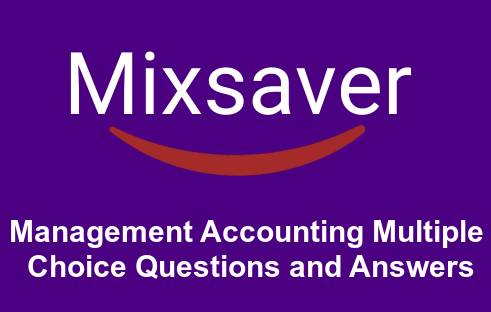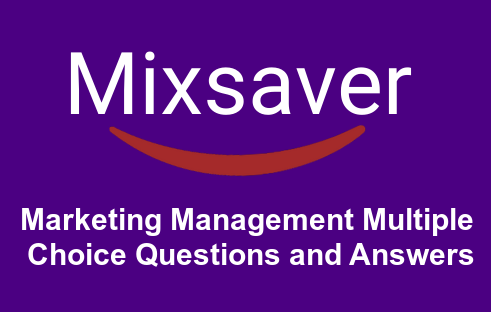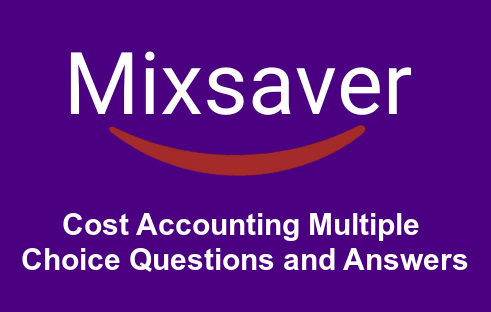Management Accounting Questions and Answers pdf | Cost and Management Accounting Questions and Answers pdf
1. The role of management accounting does not normally include the function of
(b) product costing
(d) decision-making
(a) cash management
(c) planning and control
Ans. a
2. Which of the following is not a reason financial analysis is useful to investors?
(a) Current position is the base on which future performance may be build
(b) Future trends can always be accurately predicted
(c) Investors use financial statement analysis to assess the risk associated with their expected returns
(d) Past performance is often a good indicator of future performance
Ans. b
3. In relation to a company, creditors are least concerned with
(a) ts solvency
(c) its tuture share price
(b) its short-term liquidity
(d) its profitability
Ans. c
4. In relation to a company, investors are least concerned with
(b) its solvency
(a) its profitability
(c) its future share price
(d) its short-term liquidity
Ans. d
5. In comparative analysis of financial statement, the technique used is
(a) returning analysis
(c) common size analysis
(b) preference analysis
(d) graphical analysis
Ans. c
6. The net income available for shareholders is rs. 1,12,500 and total assets (excluding fictitious assets) are rs. 25,00,000. Then return on equity will be
(a) 4.5%
(c) 10%
(b) 5%
(d) 12%
Ans. a
7. The price per share is ? 150 and the earning per share is 7.5. Price earning ratio will be
(a) 20 times
(c) 10 times
(b) 5 times
(d) None of these
Ans. a
8. The price per share is 250 and the cash flow per share is 12.5. The price to cash flow ratio will be
(a) 5 times
(c) 10 times
(b) 20 times
(d) None of these
Ans. b
9. A low price to earning ratio is indicative of
(a) a firm undertaking low risk
(b) a firm undertaking high risk
(c) a firm paying low dividends
(d) None of the above
Ans. a
10. The profit margin of a firm is 5.2%, assets turnover is 3.2 times and equity multiplier is 2.2 times. Then return on assets will be
(a) 36.6%
(b) 7 56%
(d) 1.35%
(c) 3.575%
Ans. a
Management Accounting MCQ pdf download | management accounting mcq with answers pdf download
11. The formula= Net income available for shareholders /Total assets is used to calculate
(a) return on total equity
(c) return on total assets
(b) return on total debt
(d) None of these
Ans. c
12. The price per ratio divided by cash flow per share ratio used to calculate
(a) cash flow to price ratio
(c) dividend to stock ratio
(b) price to cash flow ratio
(d) None of these
Ans. b
13. The techniques used to identify financial statement’s trends include
(a) common size analysis
(b) percentage – charge analysis
(c) Both ‘a’ and ‘b’
(d) None of the above
Ans. c
14. The net income available for shareholders is 21,25,000 and total assets are 1,75.00,000. Return on total assets will be
(a) 20.8%
(b) 15.3%
(c) 14.6%
(d) 12.14%
Ans. d
15. The companies that help to set benchmarks are classified as
(a) competitive companies
(b) analytical companies
(c) benchmark companies
(d) None of these
Ans. c
16. Total assets divided by equity is used to calculate
(a) stock multiplier
(c) equity multiplier
Ans.c
17. The price per share divided by earning per share is the formula to calculate
(b) asset multiplier
(d) None of these
(a) price earning ratio
(c) pricing ratio
(b) earning price ratio
Ans. a
18. The assessment of financial statements by a shareholder is an example of
(a) vertical analysis
(c) internal analysis
(b) horizontal analysis
(d) external analysis
Ans. d
19. Horizontal analysis deals with
(a) analysis of financial statements for a number of years
(b) analysis of financial statements of one year only
(c) Either (a) or (b)
(d) None of the above
Ans. a
20. Vertical analysis deals with
(a) analysis of financial statements for a number of years
(b) analysis of financial statements of one year only
(c) Either (a) or (b)
(d) None of the above
Ans. b
Management accounting multiple choice questions and answers pdf | mcq on management accounting
21. Horizontal analysis can also be referred to as
(a) dynamic analysis
(c) time-series analysis
(b) inter-firm analysis
(d) All of these
Ans. d
22. Vertical analysis can also be referred to as
(a) static analysis
(c) cross-sectional analysis
(d) All of these
Ans. d
23. Which of the following statements are true?
1. Vertical analysis is also termed as dynamic analysis.
2. Horizontal analysis is also termed as time-series analysis.
3. Static analysis is not useful for long-term financial planning.
(a) 1 and 2
(c) 2 and 3
(b) 1 and 3
(d) 1, 2 and 3
Ans. c
24. Which of the following statements are true?
1. Fund flow statement is one of the way to analyse and interpret financial statements.
2. Cash flow statement is one of the way to analyse and interpret financial statements.
3. Common-size statement is one of the way to analyse and interpret financial statements.
(a) 1 and 2
(b) 1 and 3
(d) 1, 2 and 3
(c) 2 and 3
Ans. d
25. John N. Meyer stated that, “Vertical and horizontal analysis forms the back-bone of financial statement analysis technique”.
(a) True
(c) Cannot say
(b) False
(d) None of these
Ans. a
26. “Ratio analysis is an important method of horizontal analysis”. The given statement is
(a) false
(b) true
(c) partly true
(d) partly false
Ans. b
27. Budgetary control is a system of controlling
(b) production
(c) sales
(a) costs
(d) loss
Ans. a
28. . spells out duties and responsibilities of various executives concerned with implementing budgets.
(a) Cost sheet
(c) Budget manual
(b) Wage sheet
(d) None of these
Ans. c
29. A factor which influences all the other budgets is called
(a) key factor
(c) indirect factor
(b) direct factor
(d) None of these
Ans. a
30. Zero-base budgeting was first used by
(a) Jimmy Carter
(c) Paul Hawk
(b) CIMA, London
(d) None of these
Ans. a
managerial accounting mcqs with answers pdf | mcq of management accounting
31. The basic difference between a fixed budget and flexible budget is that
(a) a fixed budget cannot be changed whereas flexible budget can be easily changed
(b) a fixed budget is prepared for a measure of activity, whereas flexible budget is prepared for different levels of activity
(c) a fixed budget takes into consideration only the fixed expenses, whereas flexible budget takes into consideration only the variable expenses
(d) All of the above
Ans. b
32. In a flexible budget, expenses are classified as
(a) past and current
(b) direct and indirect
(c) fixed, variable and semi-variable
(d) production and administrative
Ans. c
33. Production budget is govermed by
(a) sales budget
(c) material budget
(b) fixed budget
(d) cost budget
Ans. a
34. Budgetary control is useful for the control of cost relating to
(a) short-term budget
(b) medium-term budget
(d) None of these
(c) long-term budget
Ans. a
35. Budget is prepared
(a) before a specified period
(b) during a specified period
(c) after a specified period
(d) None of these
Ans. a
36. .. budget lays more stress on control aspect.
(a) Master
(c) Flexible
(b) Fixed
(d) Responsibility
Ans. d
37. . is a method of budgeting whereby all activities are re-evaluated every time a budget is formulated.
(a) Traditional method
(b) Zero-based budgeting method
(c) Flexible budgeting
(d) None of the above
Ans. b
38. .. is an estimate of what is likely to happen.
(a) Budget
(c) Program
(b) Forecast
(d) None of these
Ans. b
39. Production during a period equals to
(a) Sales + Closing stock – Opening stock
(b) Sales Closing stock + Opening stock
(c) Sales + Closing stock + Opening stock
(d) Sales – Closing stock – Opening stock
Ans. a
40. The . . budget is the foundation upon which other functional budgets are built.
(a) cash
(b) master
(c) sales
(d) production
Ans. c
Financial and management accounting mcq pdf | management accounting questions and answers for mba pdf
41. If a company issues bonus shares, its debt equity ratio will
(a) remain unaffected
(c) decline
(b) improve
(d) None of these
Ans. a
42. The debt equity ratio of a firm is 2:1. The amount of debt is rs. 4,00,000. What will be the value of the total assets of the company?
(a) rs. 4,00,000
(c) rs. 6,00,000
(b) rs. 8,00,000
(d) rs. 2,00,000
Ans. c
43. The ideal debt equity ratio is
(a) 1:1
(c) 2:1
(b) 1:2
(d) 3:1
Ans. b
44. An asset is a
(a) source of fund
(c) inflow of fund
(b) use of fund
(d) None of these
Ans. b
44. An asset is a
(a) source of fund
(b) use of fund
(c) inflow of fund
(d) none of these
Ans. b
45. For a company, the current ratio and quick ratio for 2014 were 3:1 and 2:1 respectively. For the same company, these ratios were 3:1 and 1:1 in 2015, This is indicative of
(a) higher liquidity
(c) lower liquidity
(b) higher stock
(d) lower stock
Ans. b
46. Authorised share capital of a company is 5 lakhs. 40% of it is paid-up. Loss incurred during the year is 50,000. Accumulated loss carried forward from last year is 2 lakhs. The company has a net worth of
(a) rs. 1 lakh
(b) rs. 50,000
(C) rs. 25 lakh
(d) Nil
Ans. b
47. Proprietary ratio is calculated by
(a) total assets/total outside liability
(b) total outside liability /total tangible assets
(c) fixed assets/long-term source of fund
(d) proprietors’ funds/total tangible assets
Ans. d
48. Current ratio of a business is 1:1. Its net working capital will be
(b) negative
(d) cannot be computed
(a) positive
(c) nil
Ans. c
49. Current ratio of a business is 4:1. It’s net working capital is rs. 3,00,000, Find the value of current assets.
(a) Rs. 4,00,000
(c) rs. 2,00,000
(b) rs. 3,00,000
(d) None of these
Ans. a
50. Current ratio of a company is 2:5. Its current liability is rs. 3,00,000. The net working capital for the business will be
(b) rs. 3,00,000
(d) rs. 3,00.000
(a) rs. 1,80,000
(c) rs. 1,80,000
Ans. c
Management Accounting Exam Questions and Answers pdf
51. Quick assets do not include
(a) marketable securities
(b) book debts
(c) advance for supply of raw materials
(d) inventories
Ans. d
52. Financial leverage means
(a) use of more debt capital to increase profit
(b) high degree of solvency
(c) low bank finance
(d) None of the above
Ans. a
53. The capital gearing ratio is high for a company. It indicates a position of
(a) low debts
(b) high preference capital
(c) high equity
(d) low debt-equity ratio
Ans. d
54. …. is used to evaluate relationships between financial terms
(a) Accounting ratios
(c) Control ratics
(b) Ratio analysis
(d) None of these
Ans. b
55. Ratio analysis focuses on
(a) lability
(c) solvency
(b) protitability
(d) All of these
Ans. d
56. ratios deal with relationship between two individua items appearing in the profit and loss statement.
(a) Solvency ratios
(b) Cormbined ratios
(c) Operating ratios
(d) None of these
Ans. c
57. Capital employed can be calculated with the help of following formula
(a) Share capital + Reserves and surplus + Long-term loans + Non-operating assets + Fictitious assets
(b) Share capital + Reserves and surplus + Long-term loens – Non-operating assets – Fictitious assets
(c) Share capital + Reserve and surplus -Long-term loans + Non-operating assets – Fictitious assets
(d) Share capital – Reserves and surplus + Long-term debts + Non-operating assets – Fictitious assets
Ans. b
58. Return on shareholder’s funds = Net profit after interest and tax
(a) Shareholders’ funds x 100 Net profit before interest and tax
(b) x 100 Shareholders’ funds Net profit after interest before tax
(c) x 100 Shareholders’ fünds
(d) Net profit after interest, tax and preference dividend x 100 Shareholders’ funds
Ans. a
59. Which ratio expresses the relationship between gross profit and net sales?
(a) Activity ratio
(b) Operating ratio
(c) Gross profit ratio
(d) Net profit ratio
Ans. c
60. Fixed asset turnover ratio =
(a) Net sales + Fixed assets
(b) Net sales – Fixed assets
(c) Net sales x Fixed assets
(d) Net sales / Fixed assets
Ans. d





